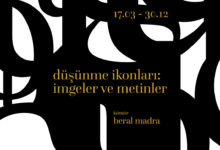SMALL IS BEAUTIFUL/KÜÇÜK GÜZELDİR
YEŞİM AĞAOĞLU, DİLARA AKAY, ERDAĞ AKSEL, ESRA CARUS, NEJAT ÇINAR, SEÇİL EREL,EDA GECİKMEZ, ŞAKİR GÖKÇEBAĞ, HAKAN GÜRSOYTRAK, NACİ GÜNEŞ GÜVEN, AHMET DOĞU İPEK, MELİKE KILIÇ, KOMET, MURAT MOROVA, NAZLI EDA NOYAN, ARDAN ÖZMENOĞLU, YENER PINARBAŞ, NİLHAN SESALAN, ANİ SETYAN, TUNCA SUBAŞI, JOSEPHINE TURALBA, UYGUR YILMAZ.
23 Eylül – 27 Aralık 2014
Kuad Gallery has been inspired by the esteemed economist and thinker Ernst Friedrich Schumacher and renamed its latest exhibition after his valued recollection of his essays in 1973, ‘Small is Beautiful’, which, recently, has regained a well-deserved attention in the context of the last decade’s economical crises.
The same name has also been preferred by several other exhibitions where art works of small size were presented to the public. In accordance with the concept, in our latest exhibition, various paintings, sketches, designs, photographs, video works and installations of small-scale will be presented.
And the aim of our exhibition is to experience the possible methods and genres of aesthetics as how to overcome the negative impacts of social and economic crises on art. However, these methods and genres have been well known to public since the ‘replicas’, ‘readymades’ and ‘editions’ of Marcel Duchamp. Despite the fact that those artworks had been made to enforce the attainment of low-income social groups to the artworks, it could not have prevented those ‘pseudo-cheap’ pieces from falling into the hands of the rich as expensive objects.
Let us herewith paraphrase Schumacher’s approach once more: In 1970s, the world was mainly divided between the two systems of Capitalism and Communism where the social perception and approaches were accordingly polarized. During that period, though two oil-crises have been overcome, after 40 years when the Wall Street crisis in 2008-2010 occurred with a devastating outcome on world economy, it started new discussions and debates on the global impacts of Neo-capitalist systems. And in 2011, upon the centenary of Schumacher, numerous economists and analysts have started re-evaluating and re-presuming his approaches.
As for Schumacher, the drive for unlimited profit making and progress inevitably causes an unrestrainable alienation effect on the individual to his/her society where the giant enterprises and organizations presume and qualify those individuals only if they act in accordance with the system itself. Thus, this ongoing vicious circle creates a vast waste of resources, environmental pollution and inhuman working conditions. In recent definitions of Modernism, the term of ‘production’ is presumed as a solved process, based on the assumption that a comprehensive solution is always possible as long as the developed countries keep transferring the means of education and technology to the underdeveloped countries. At this very point, Schumacher raises a question replied by an immediate answer of his own: ‘What can I really do?’ The answer is not only simple but surprising, too: ‘Each and every one of us should try to pull himself/herself together. What will lead us in our effort is neither science nor technology with its sustained value and goal. The enlightenment and rescue lie in the traditional wisdom of humanity itself.’*
And after 40 years, we know that we are still going through the same path. We also know that the present production system that is focused on continuous growth, big-scale economies and greatness will inevitably end up in exhaustion of natural resources. And we are well aware of the fact that we have to achieve a new economic system with new production and consumption techniques for a sustainable way of life. But at the same time, we keep discussing the position of art within the existing system and we believe that this system, focused on constant growth, is continuously interfering with the artworks on its content and form which, in return, leave the artists in the middle of a relentless struggle.
As we analyze the works of the artists from Turkey and from other countries in terms of a relational affinity of aesthetics to the aforementioned interference, we observe that Schumacher’s approach constitutes an important background. We cannot ignore the fact that the artists’ approaches and their works, if had been presumed by the system itself, could have and still can easily produce a mutual support and reciprocity.
Our proposition via the present exhibition is that the artists produce their works by asking themselves the question ‘what can I really do?’ and the meaning of these works, in terms of aesthetics, notion and social responsibility is of great value. So, contrary to the concept of ‘greatness’, which is constantly being imposed by the economic systems, we claim and insist that ‘Small is Beautiful’.
Beral Madra
*****************************************************************************************
Kuad Galeri’nin bu sergisinin başlığı iktisatçı ve düşünür Ernst Friedrich Schumacher’in 1973’te yazılarını topladığı ve son 10 yıldır dünyanın içine girdiği ekonomik krizi bağlamında yeniden gündeme gelen “Küçük Güzeldir” başlıklı kitabından ödünç alındı.
Sanat üretimi alanında bu başlık bir çok sergide, özellikle küçük heykellerin sergilenmesi açısından kullanıldı. Bu sergide de üretimlerinde ölçü açısından küçük olarak niteleyebileceğimiz resim, desen, fotoğraf, video ve yerleştirmeler yapan sanatçılar yer alıyor.Ancak serginin ana amacı ekonomik göstergelerin krizlere dönüştüğü, bireysel ve toplumsal yaşamın olumsuz etkilendiği dönemlerde sanat üretiminin hangi yöntem ve estetikle kendi alanını da etkileyen bu olumsuzluğun üstesinden gelebileceğini deneyimlemek.
Kuşkusuz bu yöntem ve estetikler Marcel Duchamp’dan günümüze “çoğaltmalar”, “özgün baskılar” “edisyonlar” gibi çözüm örnekleriyle bilinmektedir. Üretildikleri dönemde sanat üretiminin alım gücü dar olan geniş kitlelere ulaşmasını sağlamak amacıyla bulunan bu çözümler sonuçta bu söz gelimi “ucuz” yapıtların, bir dönem sonra “pahalı” sınıfına geçmesine de engel olamamıştır.
Schumacher’in yeniden gündeme gelen savını açımlayalım: 1970’lerde iki kutuplu dünyada iki ekonomi – Kapitalizm ve Komünizm- iki seçenek olarak düşünülüyor ve savunuluyordu.
Bu süre içinde bir iki petrol krizi atlatıldı; ancak 40 yıl sonra 2008 – 2010 arasında Wall Street krizi küresel bağlamda sarsıcı etki yarattı ve Neo-kapitalist Küreselciliğin sorgulanmasına neden oldu. 2011’de Schumacher’in doğumunun 100. yılında birçok ekonomist ve düşünür onun kitabındaki ilkeleri yeniden gündeme getirdiler. Schumacher’e göre özetle Modernizm sürecinde sınırsız kâr ve ilerleme, insanı doğaya ve yaşadığı topluma yabancılaştırıyor; Kapitalist sistemin altyapısını oluşturan ve diri tutan dev kuruluşlar/kurumlar insanı ancak bu sisteme uyum sağladığında değerlendiriyor; Bu sınırsız döngünün, kaynakların sorumsuzca israfına, çevre kirlenmesine ve insanlık dışı çalışma koşullarına neden oluyor; Modernizm’de “üretim” her yönüyle çözülmüş bir sorun olarak kabul ediliyor; zengin ülkelerin yoksul ülkelere eğitim ve teknoloji transferi yapmasıyla üretim sorununun en geniş çapta çözülmüş olduğu sayılıyor. Ve Schumacher şunu soruyor ve yanıtlıyor:
“Gerçekten ne yapabilirim?” Yanıtı şaşırtıcı olduğu kadar basittir de: Her birimiz kendi
içimize bir çekidüzen vermeye çalışabiliriz. Bu çabamızda elimizden tutup yol gösterecek olan, değeri tamamen hizmet ettiği amaca bağlı olan bilim ve teknoloji değildir; insanlığın geleneksel bilgeliğindedir aradığımız yol gösterici.*
Biz 40 yıl sonra bütün bunları yaşıyoruz ve biliyoruz. Sürekli büyümeye ve büyük projelere odaklanmış üretim sisteminin doğanın tükenmesi anlamına geldiğini artık kabul ediyoruz. Yeni üretim yöntemleriyle, yeni bir tüketim modeliyle, sürdürülebilir bir yaşam için yeni bir ekonomi ve yaşam biçimi kurmamız gerektiğini de biliyoruz. Sanatın da mevcut ekonomik sistem içindeki yerini tartışıyoruz ve çoğu kez sanat üretiminin de bu her şeyi büyük, yeni isteyen, sürekli büyüme ve değişim gerektiren ekonomik sistemde içerik ve estetik açıdan müdahale gördüğünü, sanatçıların da ikilemli bir pozisyona girdiklerini ve sürekli mücadele etmek zorunda olduklarını düşünüyoruz.Türkiyeli ve uluslararası sanatçıların ilişkisel estetik bağlamında ürettikleri yapıtlara baktığımızda tam da Schumacher’in düşüncesinin önemli bir altyapı oluşturduğunu izliyoruz. Sanatçıların düşünceleri ve sanat yapıtlarının sunduğu göstergeler ekonomi için bir bilgi kaynağı olabilir ve sanat ile ekonomi arasında bir karşılıklılık oluşabilir.
Bu sergide savımız sanatçıların her zaman “gerçekten ne yapabilirim?” diye sorarak üretim yaptıkları ve bu üretim “küçük” olsa bile içerdiği düşünce, estetik ve toplumsal sorumluluk açısından “büyük” anlamlar taşıdığıdır. Bu bağlamda, ekonominin sürekli “büyük” tasavvuru yaratmasına karşı “Küçük Güzeldir” diyoruz.
Beral Madra
* Küçük Güzeldir (Small is Beautiful/A Study of Economics As If People Mattered F. Schumacher Varlık Publications, Istanbul 2010 (pp.356)





